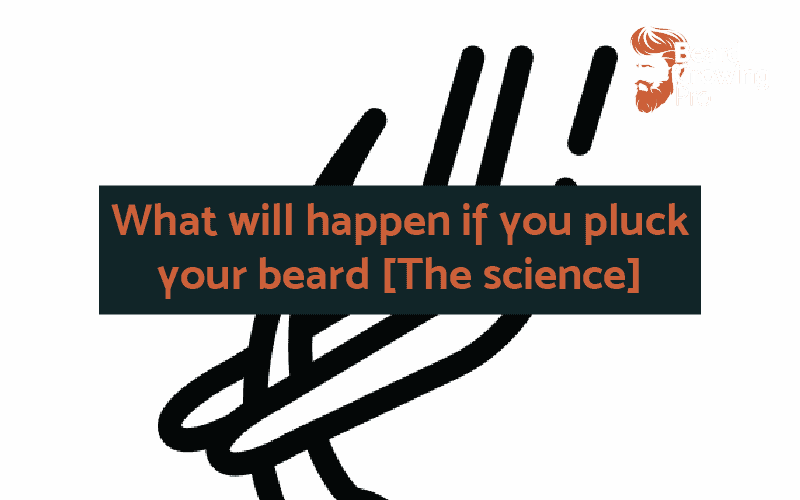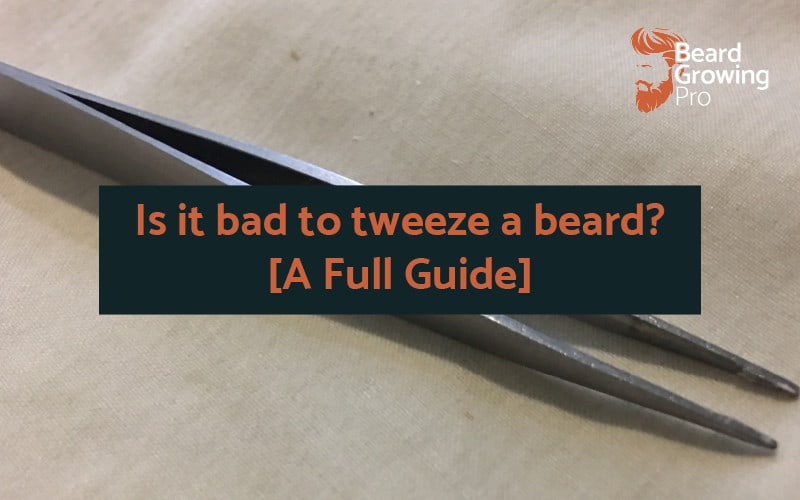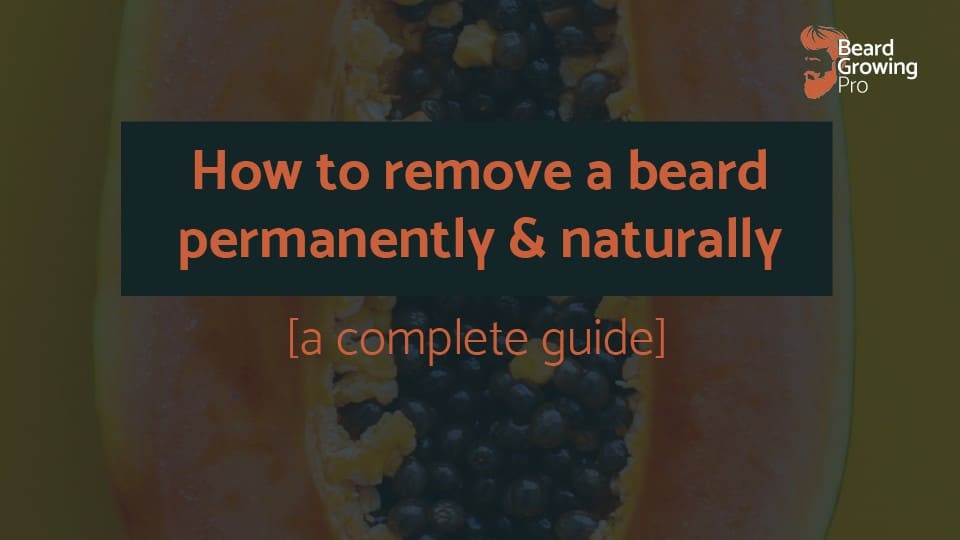There are several genuine reasons why you may want to pluck parts or all of your beard hair. Plucking your beard hair isn’t necessarily a bad thing as long as you do it safely and you understand the risks involved.
If you pluck your beard hairs, you could experience pain and irritation, an increased amount of ingrown hairs, thinning of the beard and damage to the hair follicle resulting in thinning. However, done properly, it can tidy up beard lines very effectively.
There are many other options for tidying up your beard, including shaving, electrolysis, hair removal cream and waxing if you do not like the idea of plucking out your beard.
This article will go over everything you need to know about what happens when you pluck your beard and how to do it safely.
If you pluck beard hair, the hair may be removed in several ways. Firstly, the hair may be removed from the follicle to the root. This outcome means that the hair follicle will need to regrow an entire hair which will likely grow back thinner and take longer to grow.
Alternatively, plucking beard hair may cause the hair to snap at the level of the skin. This outcome will result in beard hair that grows back as if it has been shaved. You may be able to see the hair regrowth in as little as two days.
The last thing that can happen if you pluck a beard hair is damaging the hair follicle and the hair bulb. This outcome may damage the follicles ability to regrow, and the more often you pluck beard hairs, the more likely they are to become damaged to the point of not growing beard hairs.
To look at the side effects of plucking and removing hairs from the human body, a study performed in 1995 looked at the difference in growth response in women who had some hairs plucked whilst others were removed using electrolysis.
They found that plucking the hairs using tweezers reduced the hair diameter during each session. This result means that the longer you pluck the same hairs out from your beard, they are more likely to become thinner.
Whether or not you can expect the same results on your beard is still yet to be determined by science.
Is plucking/tweezing your beard bad?
It is not bad to tweeze or pluck parts of your beard. You can do it to maintain the cheek lines and the shape of the beard. If you want to know more about whether or not it is bad to tweeze your beard check out my full guide – click here.
As long as you are putting sanitation of your tweezers and cleanliness of your hands at the forefront of plucking or tweezing your beard, it is likely you will only experience the pain from the initial plucking.
By not adhering to good hygiene practices, you may find yourself in a more painful situation due to infections introduced to your skin through the open pores and capillaries from plucking.
Why you may want to do it
Removing your beard through plucking can be a very effective way to clean up the lines of your beard.
Many people decide to pluck out hairs along the edge of their beards to maintain a sharp and crisp look.
Pulling out the hairs along the cheek line, neckline, and other sides of the beard means you are likely to go longer without shaving those areas. There is no doubt that there is a little bit of pain involved – something you could potentially get used to – and for some people, it is more than worth it.
I like to shape up the lines of my beard using a single blade safety razor which enables me to maintain a sharp-looking beard without the pain of plucking.
Some people also pluck their beards for full beard removal. This action can be incredibly painful, depending on the density and thickness of the hairs. Suppose you want to know how to remove a beard permanently using natural and less painful approaches. In that case, you should check out my other article – how to remove a beard permanently and naturally.
Complications from plucking your beard
If you do not pluck your beard safely, removing it by pulling the roots out of the skin could result in several dangers.
Just like waxing, you are likely to experience undesirable side effects such as pain, redness, sun sensitivity, localised bleeding, rashes, ingrown hairs and potential infection if you do not do it properly.
Let’s take a look at these issues below.
Pain and irritation
pulling beard hairs out of the root can cause a fair amount of redness and short-term pain.
The initial pain and irritation you can experience by plucking out your beard hairs can be decreased by using the right technique.
Using the right tools, holding the skin taught and applying the appropriate after-care such as skin-soothing balms and irritation reducing creams can significantly reduce the pain and irritation of plucking your beard.
When you are tweezing and plucking your beard, you can be very precise about the area you are clearing of hairs. Plucking a small area repetitively can cause a significant amount of irritation to a small area of your skin. Making sure that you give your skin some time to recover after the plucking will help reduce the amount of time it takes to recover from plucking your beard hairs.
Ingrown hairs
Beard hair is particularly thick, and it can result in the formation of ingrown hairs. Because beard hairs are particularly curly, they can easily grow sideways under the skin. If the hair is not properly or thoroughly removed during the tweezing, it can increase the likelihood of ingrown hairs.
To prevent ingrown hairs, you should try to remove all of the beard hair from the root. Grabbing as close to the root as possible and pulling in the direction of the hair growth is the best way to ensure that the hair doesn’t snap off.
If you find that your beard hair snaps off regularly at the skin’s surface, you may want to look at ways to increase the strength of your hair, including collagen supplementation and improving your diet to help your beard grow healthy and strong.
Thinning of beard
If you pluck your beard regularly, there is a very small but real chance that you could thin out your beard.
If you pull out your beard hair too often, it will cause damage to the hair follicle. The damage sustained to the hair bulb and the reduction in blood supply to the root could cause areas of your beard to thin out.
If you want to know more about if beard hair will grow back when it is plucked, check out my other article – click here – where I go through everything you need to know, including some counterintuitive science.
Each time you pluck out the hair, you risk damaging the hair bulb and causing smaller localised scarring, which can limit the blood flow to the hair as it grows.
If a beard hair is pulled out, it will grow back after resting, which can be anywhere from 2 to 4 weeks. If you notice that your hair takes significantly longer than four weeks to start to grow back, you may have irreversibly damaged the follicle.
Infections
Suppose you are not sterilising your tweezers and washing your hands before plucking your beard. In that case, you will likely end up introducing infections and bacteria into the fresh open wound caused by plucking.
The diameter of the beard hairs is particularly wide, which means that plucking beard hairs provides a much larger area in which bacteria can enter the body and grow.
Bacterial folliculitis is a common infection of the hair follicles caused by blockages, fungus, plucking of hair, and other less common causes. It creates very tiny red and white pimples which are filled with pus.
Besides these obvious signs of skin infection, you may also be noticing other types of symptoms, including:
- redness
- swelling
- light sensitivity
- body aches and pains
- fatigue
- headaches
The moment that you feel that your skin has become infected, it may escalate into a much more serious infection that can spread to other parts of the body. Seek help from your trusted medical professional as soon as you notice an escalation in symptoms from plucking your beard.
Avoid these areas
There are a couple of places on the face that you should avoid plucking. These areas include moles and near your nostrils.
Moles
You should avoid tweezing your beard on moles. Often, moles are hairy, but tweezing them can lead to inflammation and infection due to the skin elasticity around the hair follicle in a mole.
Near nostrils
Tweezing near nostrils is a very risky business. You should never tweeze nose hair as the nose hair is there to prevent infection and bacteria from entering your body. Also, the middle of your face is called the danger triangle, and you should avoid damaging it in any sense.
How to pluck your beard safely
Removing your beard hairs safely along the cheek line and the neckline is completely achievable as long as you follow some very simple rules.
Pull out hairs close to the root
Use the tweezers to grab the beard hair as close to the root as possible.
Grabbing the hair close to the root will ensure that the hair does not snap off during pulling and protects the root’s skin from excess pulling and strain.
Use clean tweezers
Make sure that you use clean tweezers when you are pulling out your beard hairs. Using isopropyl alcohol or another disinfectant spray will minimise the chance of you spreading infections to hair follicles and the skin underneath the beard.
Pull at the angle of growth
Pulling at the angle of growth will minimise any damage you caused to the root.
Beard hairs very rarely grow directly perpendicular to the skin. Often the beard hairs grow at an angle which can cause extra curliness in the beard hair.
Pulling the beard hair out at the growth angle means not damaging the skin closely, hugging the hair as it emerges.
Ensuring that you do not damage the hair follicle and the surrounding skin is important if you want the hair to grow back and not cause scarring or other visible marks.
Other options for hair removal
Tweezing your beard can be painful, and there are plenty of other options on the market that can reduce the initial pain of tweezing and plucking your beard and provide much better, longer-lasting results:
- hair removal cream –Facial hair removal cream is similar to shaving in that it can remove hair from the surface of the skin, but it will struggle to remove hair roots in the hair follicle.
- Electrolysis – electrolysis is a method of removing hairs from the face or body which destroys the growth centre of the hair with chemical or heat energy. After a fine metallic probe is inserted into the hair follicle, the hair is removed easily with tweezers.
- Laser hair removal – Laser hair removal is one of the most commonly undergone cosmetic procedures in the US. It works by shooting highly concentrated lights onto hair follicles. The dark hair follicles readily absorb the light energy, which destroys the hair from the inside out.
- Shaving – shaving is one of my favourite techniques to clean up my cheek line. I use a single blade safety razor.
- Waxing – Although waxing is painful on sensitive areas of the body such as the face – it may be a suitable alternative for people without sensitive skin who want a longer-lasting effect from their grooming efforts.
The final word
This article has gone through everything you need to know about what happens if you pluck your beard hair.
Making sure that your beard hair is plucked with clean and sterile equipment in a clean environment will ensure that you minimise any of the nasty, long-term side effects of plucking your beard.






